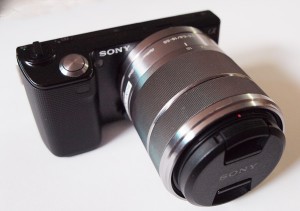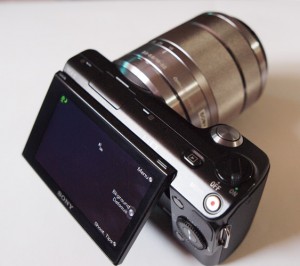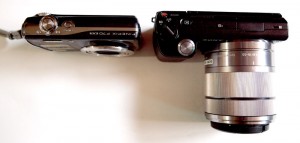 When Sony launched the Alpha NEX-5 and NEX-3 digital cameras, the company boasted that it had achieved SLR-quality images in a body that was comparable to a small point-and-shoot. Though not entirely true, the final result here is likely a game-changing move that will force competitors to trim the fat even more on their own Micro Four-Thirds cameras.
When Sony launched the Alpha NEX-5 and NEX-3 digital cameras, the company boasted that it had achieved SLR-quality images in a body that was comparable to a small point-and-shoot. Though not entirely true, the final result here is likely a game-changing move that will force competitors to trim the fat even more on their own Micro Four-Thirds cameras.
Sony has touted this new NEX series as the “world’s smallest interchangeable lens camera”, and is meant to compete with other cameras that offer slim bodies with interchangeable lenses. This burgeoning category of non-DSLR cameras, sometimes referred to as “Micro Four-Thirds” because of their mirrorless design. In other words, the lack of a mirror assembly inside — a key component to an SLR — allows manufacturers to make a smaller body without sacrificing the size of the sensor too much. Hence, why Sony, Panasonic, Olympus and others entering the space can claim to be so close to emulating DSLR performance with these things.
But the NEX-5 and NEX-3 are on another level in a variety of ways. The form factor and weight are the two that naturally come first. Though a bigger 18-55 lens we had attached added some bulk to it, the NEX-5 we reviewed is incredibly small for a camera that offers as much of a feature set as this does. Though we weren’t able to compare it to some of the other Micro Four-Thirds cameras currently on the market, we can still attest to the many upsides the NEX-5 had in our tests.
We should mention that the NEX-5 is built with a magnesium alloy body, while the NEX-3 is made of plastics. That could make a difference in durability. Sony created a new E-mount for these bodies, so only E-Series lenses will fit snugly on the NEX-5. Any Alpha series lens can work with the camera, except it will require a $250 adapter to make it happen. Not to mention that you lose the ability to auto-focus as well.
Inside, the NEX-5 uses an APS HD sensor with a digital factor of 1.5x, meaning that you can get some extra range (for example, 18mm can translate to a wide-angle 27mm). Image stabilization is also built-in, making it easier for casual shooters to keep images in focus, even when hands are shaking a bit. This translates into great photos, even at night, but low-light shots indoors offer mixed results with high ISOs.
 Before we delve further into image quality, we should mention a bit more about the NEX-5’s design. The 3” LCD screen tilts up to an 80-degree angle, and down to a 45-degree angle, making it easier to shoot above or below a subject. Since there’s no viewfinder, the screen is the only way to view a subject, and we were pleased to see that glare from the sun didn’t hinder shooting in any way. The flash mount at the top is proprietary, so nothing but a Sony-made flash will fit there. The dedicated video button is handy for capturing footage quickly up to 1080i (the NEX-3 is limited to 720p), and the playback button lies not too far away.
Before we delve further into image quality, we should mention a bit more about the NEX-5’s design. The 3” LCD screen tilts up to an 80-degree angle, and down to a 45-degree angle, making it easier to shoot above or below a subject. Since there’s no viewfinder, the screen is the only way to view a subject, and we were pleased to see that glare from the sun didn’t hinder shooting in any way. The flash mount at the top is proprietary, so nothing but a Sony-made flash will fit there. The dedicated video button is handy for capturing footage quickly up to 1080i (the NEX-3 is limited to 720p), and the playback button lies not too far away.
Two silver buttons next to the screen function in different ways that depend on what’s displayed on screen. This proves to be useful in reducing the clutter of too many buttons, especially considering that neither NEX camera has touchscreen capabilities. The scroll wheel for navigating through menus, photos and zoom functions served us well, as did the standard clickable options on each side. There are both HDMI and USB ports, plus both NEX models accept either Memory Stick or SD cards. Kudos to Sony for finally opening up to the SD card here.
The menu system is brand new, and entirely different from CyberShot and Alpha cameras, and Sony made the bright move of including short and snappy explanations for each of its features. One of these that casual users might learn to appreciate is the Background DeFocus Control, which allowed us to blur the background continuously using the scroll wheel. This worked for us in Auto mode as well. While Defocus Control shows tangible results, we found that it was easier to determine just how much blur was applied in brighter settings than in lower-light ones.
We also enjoyed trying out the NEX-5’s Twilight Handheld mode for night shots without a tripod (or flat surface), as well as the Auto HDR for shots with challenging exposures. Anti-motion blur helped us shoot motion and hold it still, though some more work needs to be done on this one. And 3D Sweep Panorama offers the possibility of viewing landscapes on 3D-enabled TVs, a unique feature that we weren’t able to truly test, though we did see it in action at a Sony event earlier this year.
Generally speaking, we were very pleased with the quality and resolution of the shots the NEX-5 captured. It was great to be able to shoot in JPEG+RAW, putting the 14.2-megapixels to good use. Colour reproduction and saturation was some of the best we’ve seen, even compared to some DSLRs. We found the dedicated modes to offer some excellent results, too. And we were also pleasantly surprised at the burst rate of 2.3 frames per second on every mode, except Speed Priority, which bumps that up to an impressive 7 fps. Of course, the faster burst rate only works the best with a fast memory card, which we didn’t have access to, unfortunately.
As mentioned earlier, video footage was impressive as well. Though the NEX-5 shoots at a lower 17 Mbps (compared to 24 Mbps for HD camcorders), the overall quality and audio fidelity were still comparable with cameras in the same category and feature set. If Sony can muscle in the ability to do 24 Mbps in the next line of NEX cameras, they could potentially create another game-changing innovation in a dual still/video camera.
With price tags of $699 for the NEX-3 and $799 for the NEX-5, these are fairly expensive, even compared to entry-level DSLRs. But for those looking to graduate from a point-and-shoot without having to carry the bulk of a DSLR — and with the funds to invest in something new — either NEX model can serve any serious amateur photographer well.




